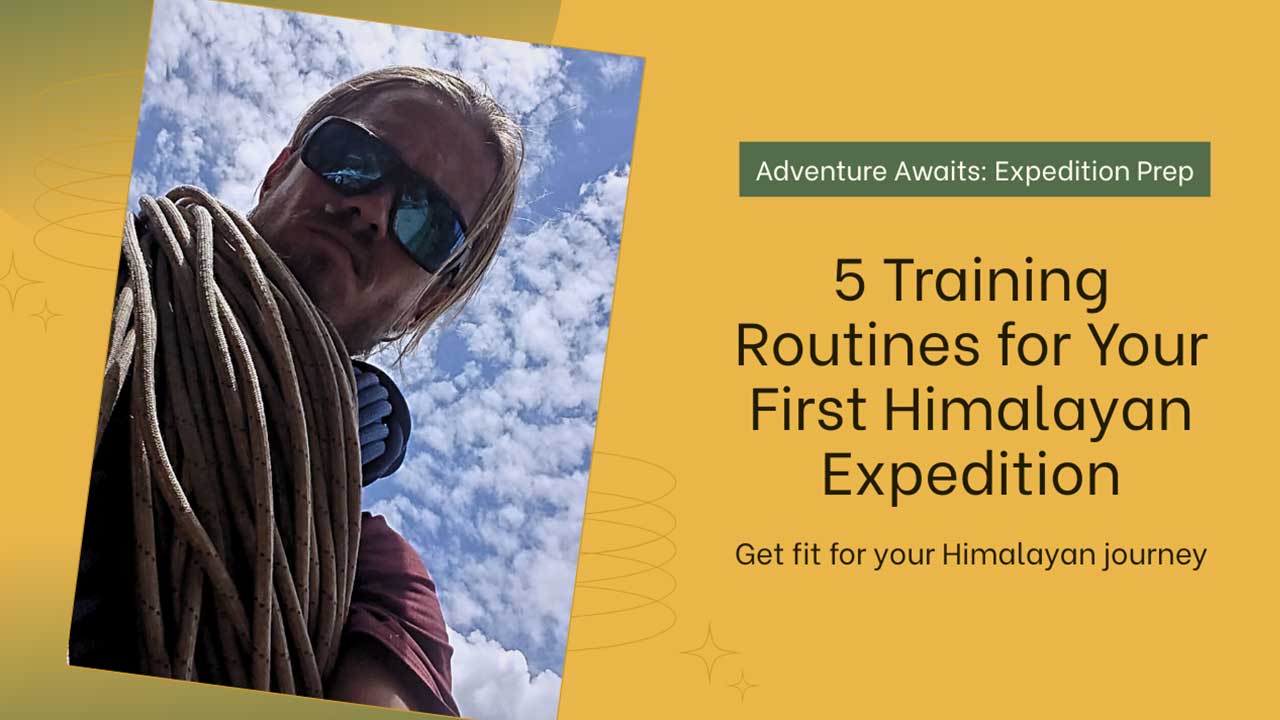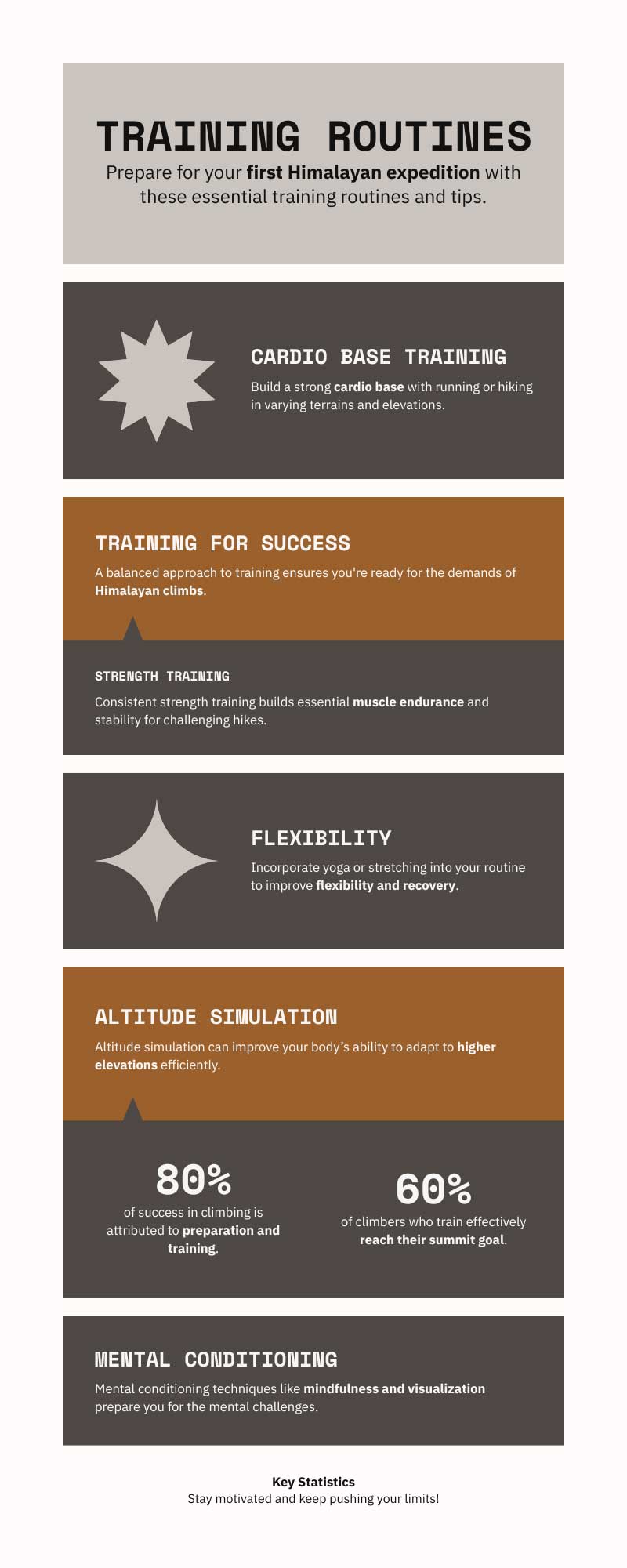5 Training Routines to Prepare You for Your First Himalayan Expedition
Blogs
Introduction
Trekking or climbing in the Himalayas is more than just a physical challenge—it’s a test of endurance, mental strength, and preparation. The trails are steep, the air is thin, and the weather is unpredictable. Whether you’re attempting your first multi-day trek or a mountaineering expedition, you can’t just show up untrained.
This guide outlines 5 highly effective training routines designed specifically for first-time Himalayan trekkers and climbers. These routines build the foundational fitness you need for safe, enjoyable, and successful high-altitude adventures.
1. Endurance Conditioning (Cardio Base Training)
Why it’s important:
At high altitudes, your oxygen intake is reduced by up to 30–50%. Without good cardiovascular health, even walking short distances feels exhausting.
Training focus:
- Build aerobic capacity to sustain long trekking hours (6–8 hours/day).
- Improve heart and lung function under stress.
Routine:
- Hiking or trekking with a loaded backpack (start with 6–8 kg and build up to 12–15 kg).
- Stair climbing or hill sprints (minimum 3x/week).
- Brisk walking, jogging, or cycling for 45–60 minutes/day.
- Mix in HIIT (High Intensity Interval Training) twice a week.
Tip:
Simulate trail conditions by training outdoors on uneven terrain with your actual boots and pack.
2. Strength Training (Legs, Core & Back Focus)
Why it’s important:
You’ll be carrying gear, climbing inclines, and managing body stability on tough terrains. Strength training helps prevent injury and supports posture.
Training focus:
- Strengthen lower body (quads, glutes, hamstrings, calves).
- Build core and back strength for balance and load bearing.
Routine: (3–4 days/week)
- Squats, lunges, and step-ups with weights
- Deadlifts and hip thrusts
- Planks, Russian twists, leg raises
- Back extensions and pull-ups (if possible)
Tip:
Use a weighted vest or backpack for compound movements to simulate climbing with load.

3. Flexibility & Mobility Work
Why it’s important:
Mountaineering movements require agility and joint flexibility. Flexibility reduces injury risks, especially during descent or scrambling.
Training focus:
- Increase range of motion in hips, ankles, shoulders, and spine.
- Prevent cramping, stiffness, and joint strain.
Routine: (Daily or after workouts)
- Dynamic stretching before workouts (leg swings, arm circles)
- Static stretching post-training (hamstring, hip, calf stretches)
- Yoga or mobility flow sessions 2–3x/week
- Include ankle mobility drills, hip openers, and thoracic spine rotations
Tip:
Practicing Surya Namaskar (Sun Salutation) sequences is highly beneficial for both strength and flexibility.
4. Altitude Simulation & Breathing Training
Why it’s important:
Altitude adaptation is tough on first-timers. You can’t train for oxygen levels, but you can condition your lungs and breathing pattern.
Training focus:
- Improve respiratory efficiency.
- Build awareness of controlled breathing under stress.
Routine:
- Box breathing and deep diaphragmatic breathing (daily)
- Breathe-hold training under guidance
- Use elevation masks or simulate breathing restrictions during cardio
- Practice nasal breathing during walks and jogs
Tip:
Try light breathing drills while hiking uphill to mimic trekking under strain. Consult your trainer if using resistance masks.
5. Mental Conditioning & Recovery Routines
Why it’s important:
Altitude, fatigue, and isolation can trigger anxiety, fear, and mental fatigue. Training your mental resilience and recovery habits prepares you for adversity.
Training focus:
- Develop patience, focus, and confidence under pressure.
- Build recovery habits that support performance and adaptation.
Routine:
- Meditate for 10–15 minutes daily
- Use visualization techniques: imagine yourself handling challenges on the trail
- Track your sleep, hydration, and nutrition
- Take active rest days with light walking, stretching, and breathing
Tip:
Keep a training journal to track your physical and emotional state. It improves self-awareness and motivation.
Final Thoughts
The Himalayas don’t reward shortcuts. Training smartly and consistently is the best gift you can give yourself before stepping onto those majestic trails or summits. Whether you’re joining a trek to Pin Parvati Pass, or preparing for a technical peak like Ladakhi Peak, these 5 routines build the stamina, strength, and mindset needed for the high-altitude world.
Want Expert Guidance?
Join a pre-expedition fitness consultation or enroll in a mountaineering preparation program with certified instructors at Ascent Descent Adventures. We offer personalized coaching, structured training plans, and hands-on workshops to prepare you for the Indian Himalayas.
Recommended Read for Preparation & Training:
- 5 Fitness Benchmarks to Know You’re Ready for Mountaineering
- 5 Skills to Master Before Joining a Mountaineering Course
- 5 Warm-Up Treks to Prepare You for a Major Climb
- 5 Things Every Beginner Mountaineer Should Do Before Their First Climb